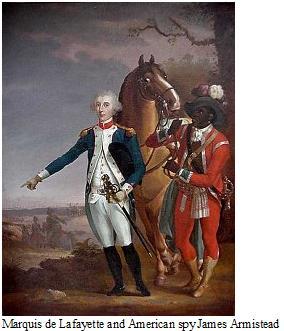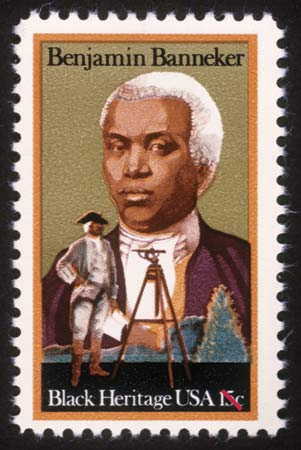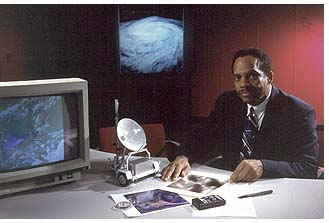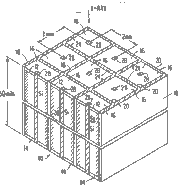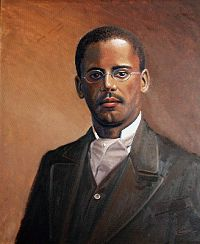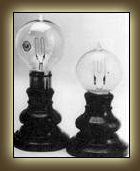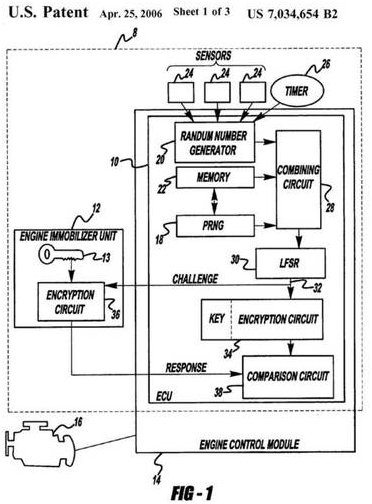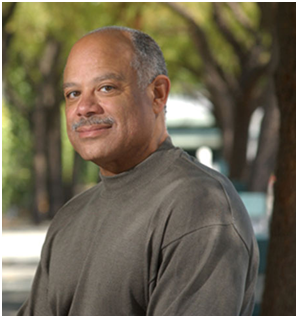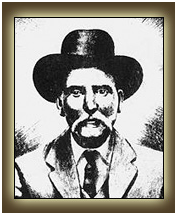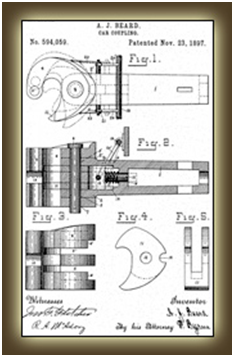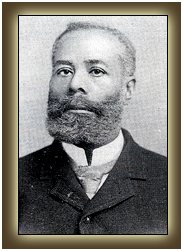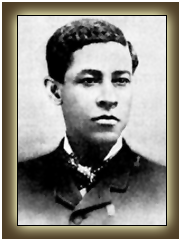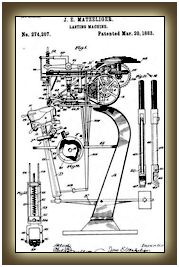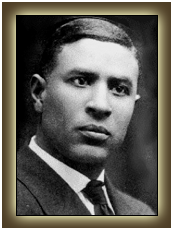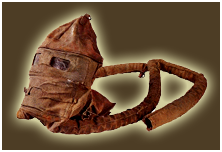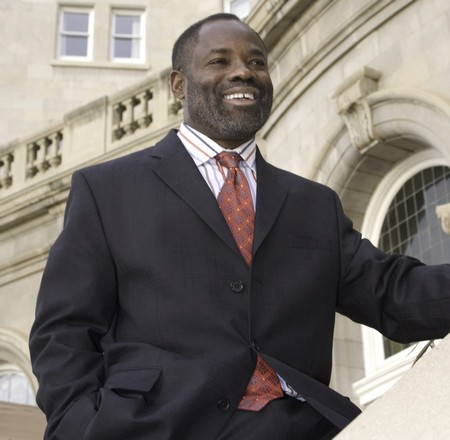Our Culture In The West
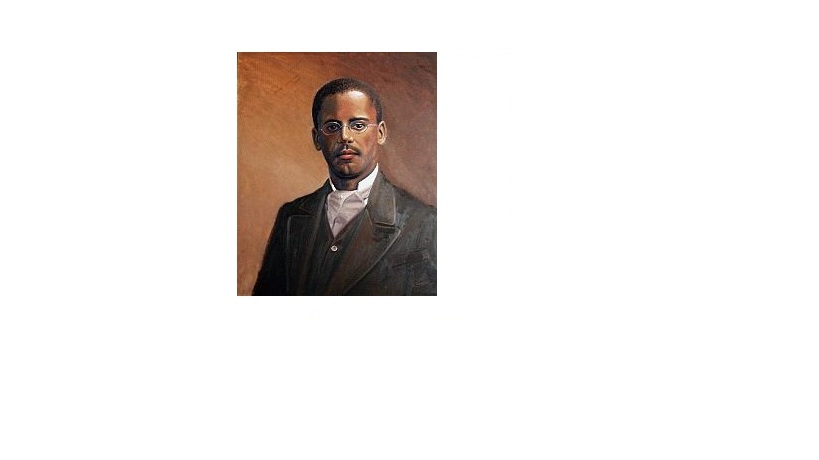
America’s Black Founding Fathers
By Bob Ellis on May 29th, 2010
Marquis de Lafayette and American spy James Armistead
Glenn Beck has been looking at the founders of American on “Founders Friday.” This week, he and some historians looked at black Americans who were present at the founding of America and had important roles in our country’s independence.
One of those was Peter Salem, who can be found in a painting of the Battle of Bunker Hill.
In the painting of the Battle of Lexington, the people assembled here are members of Rev. Jonas Clark’s congregation. They were a congregation of both black and white Americans. One of those men was Prince Estabrook, a black American.
Remember the famous painting of George Washington crossing the Delaware? Near the front of the boat you will see Prince Whipple helping row the boat, as well as a woman. All Americans were involved in winning our independence.
There is another painting of Marquis de Lafayette, the Frenchman who so greatly helped George Washington with our troops, and James Armistead. Armistead was an American double-spy who helped get information from the British and feed them bad information about us. His service was pivotal to our success at the Battle of Yorktown…which effectively won the American Revolution for us.
One of the guests on Beck’s show was David Barton, founder of WallBuilders and author of “American History in Black and White.” Another was Dr. Lucas Morel, a professor at Washington and Lee University in Virginia and author of “Lincoln’s Sacred Effort.” Barton goes into greater detail about Armistead’s role in American history, as well as the friendship between Lafayette and Armistead.
Barton also talked about Wentworth Cheswell, who is considered the first black American elected to public office. We all know about Paul Revere’s famous ride warning that the British were coming, but Cheswell rode in another direction to give the same warning.
At one point, Barton points out that obviously at some point in history, since many of these black founders show up in various paintings of the Revolution, we knew about the role of black Americans in our founding. Somewhere along the way, like many historical facts, this has been forgotten.
There is also considerable discussion of Frederick Douglass, who is better known in history and someone Beck calls a “re-founder.” Barton says Douglass once believed the “Three-Fifths Compromise” was a terrible affront to enslaved black Americans and that it rendered the U.S. Constitution totally corrupt. However, when he studied the Constitution along with the notes from the Constitutional Convention, he realized it was an anti-slavery document.
The bulk of the founders recognized that slavery was wrong and was counter to the ideals of freedom upon which the American Revolution was based. However, there were some in the South who wanted to preserve slavery in the United States, and the impasse threatened the union of our fledgling nation. As a compromise, they came up with the idea of counting slaves as “three-fifths” for the purposes of representation and apportionment.
If a slave was not worthy of freedom like any other American, then he should not really be counted for the purposes of representation and apportionment. Of course, the Southern states saw how this would hurt them in the federal government, so they compromised by counting slaves at three-fifths of a free person. It made it harder for pro-slavery states to get as much representation in congress; thus the anti-slavery states would have greater representation in apportionment…and in making laws for the nation in general. This gave the Southern states an incentive to free their slaves so that their overall population numbers would increase and thus give the Southern states greater representation and apportionment.
Of course, the truth doesn’t fit the liberal narrative of America as an evil place, a place founded by evil rich slave-owning white guys (and there is some truth to that: some founders were wealthy, and some did own slaves) that has always been a place of great inequality. The truth doesn’t advance the culture of victimhood promoted by the modern Left in America. The reality of our history–both good and bad–must be sanitized and revised and rewritten, therefore, in order for the Left to fundamentally alter our present and future public policy.
People like Lemuel Haynes (as well as some of these other black American historical figures) throw a lot of water on that revisionist narrative, however. Haynes was a black American, born to a white woman and a black man. He became a minister and pastored a church with a white congregation, and also fought in the militia in the American Revolution. Barton says that he always preached a special sermon about George Washington on Washington’s birthday every year.
There was Benjamin Banneker, a black American who was involved in the planning of Washington D.C. and was said to be very intelligent and involved with building clocks and predicting eclipses.
During the question and answer segment (below), they take on the liberal historical revisionism concerning ethnic issues and the two major political parties in America. While liberals want us to believe the opposite, history shows that it was a Republican president who sent hundreds of thousands of white Americans to die to free black Americans, Democrats who started the KKK and opposed full freedom for black Americans, and Democrats who fought full civil rights for black Americans all the way through the Civil Rights Act. Today’s Democrat Party is definitely unsurpassed in pandering to black Americans (while delivering nothing but empty promises), but history proves their despicable history as enemies of freedom (some things never change).
Our Scientist
B.S. (1962) Physics Occidental College; M.S. (1963) Nuclear Physics Howard University
Ph.D. (1967) Howard University
thesis: An Electron Impact Study of the Methylamine, Monoethylamine, Dimethylamine, and Trimethylamine;
-Asst Director For Standards /Excellence — Applied Engineering and Technology Directorate for the Goddard Space Flight Center.
George Edward Alcorn, Jr. was born on March 22, 1940, to George and Arletta Dixon Alcorn. His father was an auto mechanic who sacrificed so Alcorn and his brother could get an education. Alcorn attended Occidental College in Pasadena, California, where he maintained an excellent academic record while earning eight letters in baseball and football. Alcorn graduated with a B.A. in physics in 1962, and in 1963 he completed a master’s degree in nuclear physics from Howard University. During the summers of 1962 and 1963, Alcorn worked as a research engineer for the Space Division of North American Rockwell, computing trajectories and orbital mechanics for missiles.
In 1967, George Edward Alcorn earned a Ph.D. in Atomic and Molecular Physics from Howard University. Between 1965-67 Alcorn conducted research on negative ion formation under a NASA-sponsored grant. Dr. George Edward Alcorn holds eight patents in the United States and Europe on semiconductor technology, one of which is a method of fabricating an imaging X-ray spectrometer. His area of research includes: adaptation of chemical ionization mass spectrometers for the detection of amino acids and development of other experimental methods for planetary life detection; classified research involved with missile reentry and missile defense; design and building of space instrumentation, atmospheric contaminant sensors, magnetic mass spectrometers, mass analyzers; and development of new concepts of magnet design and the invention of a new type of x-ray spectrometer, and limbs.
After earning his Ph.D., Alcorn spent twelve years in industry. He was senior scientist at Philco-Ford, senior physicist at Perker-Elmer, and advisory engineer at IBM Corporation. In 1973, Alcorn was chosen to be IBM Visiting Professor in Electrical Engineering at Howard University, and he has held positions at that university ever since, rising to the rank of full professor. Alcorn is also a full professor in the department of electrical engineering at the University of the District of Columbia, where he has taught courses ranging from advanced engineering mathematics to microelectronics.
Alcorn left IBM, where he worked as a Second Plateau Inventor, to join NASA in 1978. While at NASA, Alcorn invented an imaging x-ray spectrometer using thermomigration of aluminum, for which he earned a patent in 1984, and two years later he devised an improved method of fabrication using laser drilling. His work on imaging x-ray spectrometers earned him the 1984 NASA/GSFC Inventor of the Year Award. During this period he also served as deputy project manager for advanced development, and in this position he was responsible for developing new technologies required for the space station Freedom. Alcorn served as manager for advanced programs at NASA/GSFC from 1990 to 1992, and his primary duties concerned the managing of technology programs and evaluating technologies which were required by GSFC. He also managed the GSFC Evolution Program, concerned with ensuring that over its 30-year mission the space station develops properly while incorporating new capabilities.
Since 1992, Alcorn has served as chief of Goddard’s Office of Commercial Programs supervising programs for technology transfer, small business innovation research, and the commercial use of space programs. He managed a shuttle flight experiment that involved Robot Operated Material Processing System, or ROMPs, in 1994. The experiment involved the manufacture of materials in the microgravity of space.
In 1999 Alcorn was awarded Government Executive Magazine’s prestigious— Government Technology Leadership Award (there were only two awards in all of NASA’s ten centers that year) for the development and commercialization of — THE AIRBORNE LIDAR TOPOGRAPHICAL MAPPING SYSTEM (ALTMS ) . In 2001 Dr Alcorn was awarded special congressional recognition by Congresswoman Donna M. Christian-Christensen (D-VI) for his efforts in helping Virgin Islands businesses through application of NASA technology and knowledge of technology programs.
Until recently, Dr. Alcorn was Chief of the Office of Commercial Programs for the Goddard Space Flight Center. In 2005 he became Assistant Director For Standards /Excellence –Applied Engineering and Technology Directorate
George Edward Alcorn, Jr. is responsible for a number of inventions now widely used in the semiconductor industry. He is perhaps best known for inventing an imaging x-ray spectrometer which uses the thermomigration of aluminum, an achievement which earned him the 1984 Inventor of the Year Award from the National Aeronautics and Space Administration (NASA) and the Goddard Space Flight Center (GSFC).
Alcorn has over 20 inventions. Some of these have been patented while others have been published. He is a recognized pioneer in the fabrication of plasma semiconductor devices, and his patent “Process for Controlling the Slope of a Via Hole” was an important contribution to the process of plasma etching. This procedure is now used by many semiconductor manufacturing companies. Alcorn was one of the first scientists to present a computer-modeling solution of wet etched and plasma etched structures, and he has received several cash prizes for his inventions of plasma-processing techniques.
Alcorn has been extensively involved in community service. In 1984, he was awarded a NASA-EEO medal for his contributions in recruiting minority and women scientists and engineers and his assistance to minority businesses in establishing research programs. He is a founder of Saturday Academy, which is a weekend honors program designed to supplement and extend math-science training for inner-city students in grades six to eight. Alcorn also works with the Meyerhoff Foundation, founded by Freeman Hrabowski, whose goal is to encourage and support African American males interested in pursuing doctorates in science and engineering. Alcorn was honored by his alma mater Howard University in 1994 in its Heritage of Greatness awards ceremony. Alcorn was celebrated as a Black Achiever in the Science and Technology category. Alcorn married Marie DaVillier in 1969; they have one son, born in 1979. Alcorn’s younger brother Charles is a research physicist at IBM
Lewis Latimer
Inventor
1848-1928
Lewis Latimer is considered one of the 10 most important Black inventors of all time, not only for the sheer number of inventions created and patents secured but also for the magnitude of importance for his most famous discovery. Latimer was born on September 4, 1848 in Chelsea, Massachusetts. His parents were George and Rebecca Latimer, both runaway slaves who migrated to Massachusetts in 1842 from Virginia. George Latimer was captured by his slave owner, who was determined to take him back to Virginia. His situation gained great notoriety, even reaching the Massachusetts Supreme Court. Eventually George was purchased by abolition supporters who set him free.
Lewis served in the United States Navy for the Union during the Civil War, assigned to the U.S.S. Massasoit gunboat and received an honorable discharge on July 3, 1965. After his discharge he sought employment throughout Boston, Massachusetts and eventually gained a position as an office boy with a patent law firm, Crosby and Gould earning $3.00 each week. After observing Latimer’s ability to sketch patent drawings, he was eventually promoted to the position of head draftsman earning $20.00 a week. In addition to his newfound success, Latimer found additional happiness when he married Mary Wilson in November of 1873.
In 1874, along with W.C. Brown, Latimer co-invented an improved of a train water closet, a bathroom compartment for railroad trains. Two years later, Latimer would play a part in one of the world’s most important inventions.
In 1876, Latimer was sought out as a draftsman by a teacher for deaf children. The teacher had created a device and wanted Lewis to draft the drawing necessary for a patent application. The teacher was Alexander Graham Bell and the device was the telephone. Working late into the night, Latimer worked hard to finish the patent application, which was submitted on February 14, 1876, just hours before another application was submitted by Elisha Gray for a similar device.
In 1880, after moving to Bridgeport, Connecticut, Latimer was hired as the assistant manager and draftsman for U.S. Electric Lighting Company owned by Hiram Maxim. Maxim was the chief rival to Thomas Edison, the man who invented the electric light bulb. The light was composed of a glass bulb which surrounded a carbon wire filament, generally made of bamboo, paper or thread. When the filament was burned inside of the bulb (which contained almost no air), it became so hot that it actually glowed.
Thus by passing electricity into the bulb, Edison had been able to cause the glowing bright light to emanate within a room. Before this time most lighting was delivered either through candles or through gas lamps or kerosene lanterns. Maxim greatly desired to improve on Edison’s light bulb and focused on the main weakness of Edison’s bulb – their short life span (generally only a few days.) Latimer set out to make a longer lasting bulb.
Latimer devised a way of encasing the filament within an cardboard envelope which prevented the carbon from breaking and thereby provided a much longer life to the bulb and hence made the bulbs less expensive and more efficient. This enabled electric lighting to be installed within homes and throughout streets.
Latimer’s abilities in electric lighting became well known and soon he was sought after to continue to improve on incandescent lighting as well as arc lighting. Eventually, as more major cities began wiring their streets for electric lighting, Latimer was dispatched to lead the planning team. He helped to install the first electric plants in Philadelphia, New York City and Montreal and oversaw the installation of lighting in railroad stations, government building and major thoroughfares in Canada, New England and London.
In 1890, Latimer, having been hired by Thomas Edison, began working in the legal department of Edison Electric Light Company, serving as the chief draftsman and patent expert. In this capacity he drafted drawings and documents related to Edison patents, inspected plants in search of infringers of Edison’s patents, conducted patent searches and testified in court proceeding on Edison’s behalf. Later that year wrote the worlds most thorough book on electric lighting, “Incandescent Electric Lighting: A Practical Description of the Edison System.” Lewis was named one of the charter members of the Edison pioneer, a distinguished group of people deemed responsible for creating the electrical industry. The Edison Electric Lighting would eventually evolve into what is now known as the General Electric Company.
Latimer continued to display his creative talents over then next several years. In 1894 he created a safety elevator, a vast improvement on existing elevators. He next received a patent for Locking Racks for Hats, Coats, and Umbrellas. The device was used in restaurants, hotels and office buildings, holding items securely and allowing owners of items to keep the from getting misplaced or accidentally taken by others. He next created a improved version of a Book Supporter, used to keep books neatly arranged on shelves.
Latimer next devised a method of making rooms more sanitary and climate controlled. He termed his device an Apparatus for Cooling and Disinfecting. The device worked wonders in hospitals, preventing dust and particles from circulating within patient rooms and public areas.
Marcelleaus P Baines
Invented a motor vehicle engine immobilizer security system and patented it on 4/25/2006
Patent Abstract: Methods and apparatus are provided for insuring that a motor vehicle is being operated by an authorized operator. The apparatus includes an electronic control unit (ECU), an engine immobilizer unit, and a shared encryption key. The ECU generates a challenge by combining the output of a pseudo-random number generator and the output of a somewhat random number generator and cycling the combined number through a linear feedback shift register. The ECU sends the challenge to the immobilizer unit where it is encrypted with the shared key and sent back to the ECU as a response. The ECU uses the same key to encrypt the challenge and compares the encrypted challenge to the response. If the response matches the encrypted challenge, engine operation is enabled.
Mark Dean
Mark Dean and his co-inventor Dennis Moeller created a microcomputer system with bus control means for peripheral processing devices. Their invention paved the way for the growth in the information technology industry. We can plug into our computers peripherals like disk drives, video gear, speakers, and scanners.
Dean was born in Jefferson City, Tennessee, on March 2, 1957. He received his undergraduate degree in electrical engineering from the University of Tennessee, his MSEE from Florida Atlantic University, and his Ph.D. in electrical engineering from Stanford University. Early in his career at IBM, Dean was chief engineer working with IBM personal computers. The IBM PS/2 Models 70 and 80 and the Color Graphic Adapter are among his early work. He holds three of IBM’s original nine PC patents. Currently, Dean is vice president of performance for the RS/6000 Division. He was named an IBM fellow in 1996 and in 1997, received the Black Engineer of the Year President’s Award. Dean holds more than 20 patents.
He was inducted into the National Inventors Hall of Fame in 1997.
Mark E. Dean and Dennis L. Moeller developed the improvements in computer architecture that allow IBM and compatible PCs to use high performance software and to work in tandem with peripheral devices. Their work enhanced the PC by enabling components to communicate with each other in a high-speed, efficient manner. The first commercial use of their patents was marketed in 1984 in the IBM PC/AT computer.
Andrew Jackson Beard
Andrew Jackson Beard hailed from Eastlake, Alabama, a small town outside of Birmingham. With the emergence of the railroad industry and its rapid expansion throughout the country, an alarming number of railmen suffered serious injuries to their arms and legs when they were crushed during manual style coupling of railroad cars. During manual coupling, a worker would have to attempt to precisely time the moment when two railroad cars being pushed together would be close enough for that worker to drop a metal pin between their connectors, thus engaging the cars. If the worker was off by one second he might severe damage his arm or leg – many in fact had to undergo amputation.
On November 27, 1897 Beard received a patent for a device he called the Jenny Coupler. The Jenny Coupler automatically joined cars by simply allowing them to bump into each other, or as Beard described it the “horizontal jaws engage each other to connect the cars.” Beard sold the rights to his invention for $50,000.00 and the railroad industry was revolutionized. On November 27, 1897 Beard received a patent for a device he called the Jenny Coupler. The Jenny Coupler automatically joined cars by simply allowing them to bump into each other, or as Beard described it the “horizontal jaws engage each other to connect the cars.” Beard sold the rights to his invention for $50,000.00 and the railroad industry was revolutionized.
During his lifetime, Beard received a number of other patents, including a steam driven rotary engine, and a double plow.
Elijah McCoy
Although the name Elijah McCoy may be unknown to most people, the enormity of his ingenuity and the quality of his inventions have created a level of distinction which bears his name.
Elijah McCoy was born in Colchester, Ontario, Canada on May 2, 1844. His parents were George and Emillia McCoy, former slaves from Kentucky who escaped through the Underground Railroad. George joined the Canadian Army, fighting in the Rebel War and then raised his family as free Canadian citizens on a 160 acre homestead.
At an early age, Elijah showed a mechanical interest, often taking items apart and putting them back together again. Recognizing his keen abilities, George and Emillia saved enough money to send Elijah to Edinburgh, Scotland, where he could study mechanical engineering. After finishing his studies as a “master mechanic and engineer” he returned to the United States which had just seen the end of the Civil War – and the emergence of the “Emancipation Proclamation.”
Elijah moved to Ypsilanti, Michigan but was unable to find work as an engineer. He was thus forced to take on a position as a fireman\oilman on the Michigan Central Railroad. As a fireman, McCoy was responsible for shoveling coal onto fires which would help to produce steam that powered the locomotive. As an oilman, Elijah was responsible for ensuring that the train was well lubricated. After a few miles, the train would be forced to stop and he would have to walk alongside the train applying oil to the axles and bearings.
In an effort to improve efficiency and eliminate the frequent stopping necessary for lubrication of the train, McCoy set out to create a method of automating the task. In 1872 he developed a “lubricating cup” that could automatically drip oil when and where needed. He received a patent for the device later that year. The “lubricating cup” met with enormous success and orders for it came in from railroad companies all over the country. Other inventors attempted to sell their own versions of the device but most companies wanted the authentic device, requesting “the Real McCoy.”
In 1868, Elijah married Ann Elizabeth Stewart. Sadly, Elizabeth passed away just four years later. In 1873, McCoy married again, this time his bride was Mary Eleanor Delaney and the couple would eventually settle into Detroit, Michigan together for the next 50 years.
McCoy remained interested in continuing to perfect his invention and to create more. He thus sold some percentages of rights to his patent to finance building a workshop. He made continued improvements to the “lubricating cup.” The patent application described the it as a device which “provides for the continuous flow of oil on the gears and other moving parts of a machine in order to keep it lubricated properly and continuous and thereby do away with the necessity of shutting down the machine periodically.” The device would be adjusted and modified in order to apply it to different types of machinery. Versions of the cup would soon be used in steam engines, naval vessels, oil-drilling rigs, mining equipment, in factories and construction sites.
In 1916 McCoy created the graphite lubricator which allowed new superheater trains and devices to be oiled. In 1920, Elijah established the “Elijah McCoy Manufacturing Company.” With his new company, he improved and sold the graphite lubricator as well as other inventions which came to him out of necessity. He developed and patented a portable ironing board after his wife expressed a need for an easier way of ironing clothes. When he desired an easier and faster way of watering his lawn, he created and patented the lawn sprinkler.
In 1922, Elijah and Mary were involved in an automobile accident and both suffered severe injuries. Mary would die from the injuries and Elijah’s health suffered for several years until he died in 1929. McCoy left behind a legacy of successful inventions which would benefit mankind for another century and his name would come to symbolize quality workmanship –
The Real McCoy!
Jan Matzeliger
Sometimes the greatest inventions are those which simplify necessary tasks. Such is the case with Jan Matzeliger – the man who made it possible for ordinary citizens to purchase shoes.
Jan Matzeliger was born in Dutch Guiana (now known as Surinam) in South America. His father was a Dutch engineer and his mother was born in Dutch Guiana and was of African ancestry. His father had been sent to Surinam by the Dutch government to oversee the work going on in the South American country.
At an early age, Jan showed a remarkable ability to repair complex machinery and often did so when accompanying his father to a factory. When he turned 19, he decided to venture away from home to explore other parts of the world. For two years he worked aboard an East Indian merchant ship and was able to visit several countries. In 1873, Jan decided to stay in the United States for a while, landing in Pennsylvania. Although he spoke very little English, he was befriended by some Black residents who were active in a local church and took pity on him. Because he was good with his hands and mechanically inclined, he was able to get small jobs in order to earn a living.
At some point he began working for a cobbler and became interested in the making of shoes. At that time more than half of the shoes produced in the United States came from the small town of Lynn, Massachusetts. Still unable to speak more than rudimentary English, Matzeliger had a difficult time finding work in Lynn. After considerable time, he was able to begin working as a show apprentice in a shoe factory. He operated a McKay sole-sewing machine which was used to attached different parts of a shoe together. Unfortunately, no machines existed that could attach the upper part of a shoe to the sole. As such, attaching the upper part of a shoe to the sole had to be done by hand. The people who were able to sew the parts of the shoe together were called “hand lasters” and expert ones were able to produce about 50 pairs of shoes in a 10 hour work day. They were held in high esteem and were able to charge a high price for their services, especially after they banded together and formed a union called the Company of Shoemakers. Because the hand lasters were able to charge so much money, a pair of shoes was very expensive to purchase. Hand lasters were confident that they would continue to be able to demand high sums of money for their services saying “… no matter if the sewing machine is a wonderful machine. No man can build a machine that will last shoes and take away the job of the laster, unless he can make a machine that has fingers like a laster – and that is impossible.” Jan Matzeliger decided they were wrong.
After working all day Matzeliger took classes at night to learn English. Soon, he was able to read well enough to study books on physics and mechanical science. This enabled him to a number of inventions. Lacking sufficient money, he was unable to patent these inventions and watched helplessly as other people claimed to have created the devises and received the financial rewards they brought. Matzeliger did not despair over these situations because he was already thinking of a more important invention – the shoe laster.
Watching hand lasters all day, Matzeliger began understanding how they were able to join the upper parts of a shoe to the sole. At night he sat devising methods for imitating the mannerisms of the hand lasters and sketched out rough drawings of a machine that might work in the same manner.
Soon, Matzeliger began putting together a crude working model of his invention. Lacking the proper materials, he used whatever scraps he could find, including cigar boxes, discarded pieces of wood, scrap wire, nails and paper. After six months, he felt he was on the right track but knew he needed better materials in order to take the next steps.
Although he attempted to keep his invention a secret, people found out, including the expert hand lasters he was trying to “compete” with. These people criticized and ridiculed him and tried to dissuade him pursuing his goal. He considered on, however, and decided to try to raise money in order to improve his working model. He was offered $50.00 to sell the device he had created up to that point but turned it down, knowing that if people were interested in buying, he was on the right track.
As he improved the device, other offers of money came in, some as high as $1,500.00. Matzeliger could not bear to part with the device he had put so much work into creating so he held out until he reached a deal to sell a 66% interest in the devices to two investors, retaining the other third interest for himself. With the new influx of cash, Jan finished his second and third models of the machine. At this point he applied for a patent for the device.
Because no one could believe that anyone could create a machine which could duplicate the work of expert lasters, the patent office dispatched a representative to Lynn, Massachusetts to see the device in action. In March 1883, the United States Patent Office issued a patent to Jan Matzeliger for his “Lasting Machine.” Within two years, Matzeliger had perfected the machine to that point that it could produce up to 700 pairs of shoes each day (as compared to 50 per day for a hand laster.)
Garrett Morgan
Garrett Morgan was born on March 4, 1877 in Paris, Kentucky the seventh of 11 children born to Sydney and Elizabeth Morgan. Garrett, at the early age of 14 decided that he should travel north to Ohio in order to receive a better education. He moved to Cincinnati and then to Cleveland, working as a handyman in order to make ends meet. In Cleveland, he learned the inner workings of the sewing machine and in 1907 opened his own sewing machine store, selling new machines and repairing old ones. In 1908 Morgan married Mary Anne Hassek with whom he would have three sons.
In 1909, Morgan opened a tailoring shop, selling coats, suits and dresses. While working in this shop he came upon a discover which brought about his first invention. He noticed that the needle of a sewing machine moved so fast that its friction often scorched the thread of the woolen materials. He thus set out to develop a liquid that would provide a useful polish to the needle, reducing friction. When his wife called him to dinner, he wiped the liquid from his hands onto a a piece of pony-fur cloth. When he returned to his workshop, he saw that the fibers on the cloth were now standing straight up. He theorized that the fluid had actually straightened the fibers. In order to confirm his theory, he decided to apply some of the fluid to the hair of a neighbor’s dog, an Airedale. The fluid straightened the dog’s hair so much, the neighbor, not recognizing his own pet, chased the animal away. Morgan then decided try the fluid on himself, to small portions of his hair at first, and then to his entire head. He was successful and had invented the first human-hair straightener. He marketed the product under the name the G. A. Morgan Hair Refining Cream and sold by his G. A. Morgan Refining Company, which became a very successful business.
In 1912, Morgan developed another invention, much different from his hair straightener. Morgan called it a Safety Hood and patented it as a Breathing Device, but the world came to know it as a Gas Mask. The Safety Hood consisted of a hood worn over the head of a person from which emanated a tube which reached near the ground and allowed in clean air. The bottom of the tube was lined with a sponge type material that would help to filter the incoming air. Another tube existed which allowed the user to exhale air out of the device. Morgan intended the device to be used “to provide a portable attachment which will enable a fireman to enter a house filled with thick suffocating gases and smoke and to breathe freely for some time therein, and thereby enable him to perform his duties of saving life and valuables without danger to himself from suffocation. The device is also efficient and useful for protection to engineers, chemists and working men who are obliged to breathe noxious fumes or dust derived from the materials in which they are obliged to work.”
The National Safety Device Company, with Morgan as its General Manager was set up to manufacture and sell the device and it was demonstrated at various exhibitions across the country. At the Second International Exposition of Safety and Sanitation, the device won first prize and Morgan was award a gold medal. While demonstrations were good for sales, the true test of the product would come only under real life circumstances.
That opportunity arose on July 24, 1916 when an explosion occurred in a tunnel being dug under Lake Erie by the Cleveland Water Works. The tunnel quickly filled with smoke, dust and poisonous gases and trapped 32 workers underground. They were feared lost because no means of safely entering and rescuing them was known. Fortunately someone at the scene remembered about Morgan’s invention and ran to call him at his home where he was relaxing. Garrett and his brother Frank quickly arrived at the scene, donned the Safety Hood and entered the tunnel. After a heart wrenching delay, Garrett appeared from the tunnel carrying a survivor on his back as did his brother seconds later. The crowd erupted in a staggering applause and Garrett and Frank reentered the tunnel, this time joined by two other men. While they were unable to save all of the workers, the were able to rescue many who would otherwise have certainly died. Reaction to Morgan’s device and his heroism quickly spread across the city and the country as newspapers picked up on the story. Morgan received a gold medal from a Cleveland citizens group as well as a medal from the International Association of Fire Engineers, which also made him an honorary member.
Soon, orders came in from fire and police departments across the country. Unfortunately, many of these orders were canceled when it was discovered that Morgan was Black. Apparently, many people would rather face danger and possibly death than rely on a lifesaving device created by a Black man. Nonetheless, with the outbreak of World War I and the use of poisonous gases therein, Morgan’s Safety Hood, now known as the Gas Mask was utilized by the United States Army and saved the lives of thousands of soldiers.
Although he could have relied on the income his Gas Masks generated, Morgan felt compelled to try to solve safety problems of the day. One day he witnessed a traffic accident when an automobile collided with a horse and carriage. The driver of the automobile was knocked unconscious and the horse had to be destroyed. He set out to develop a means of automatically directing traffic without the need of a policeman or worker present. He patented an automatic traffic signal which he said could be “operated for directing the flow of traffic” and providing a clear and unambiguous “visible indicator.”
Satisfied with his efforts, Morgan sold the rights to his device to the General Electric Company for the astounding sum of $40,000.00 and it became the standard across the country. Today’s modern traffic lights are based upon Morgan’s original design.
At that point, Morgan was honored by many influential people around him, including such tycoons as John D. Rockefeller and J.P. Morgan (after whom he named one of his sons.) Although his successes had brought him status and acclaim, Morgan never forgot that his fellow Blacks still suffered injustices and difficulties. His next endeavor sought to address these as he started a newspaper called the Cleveland Call (later renamed as the Call & Post.) He also served as the treasurer of the Cleveland Association of Colored Men which eventually merged with the National Association for the Advancement of Colored People (NAACP) and ran as a candidate for Cleveland’s City Council
In his later years, Morgan would develop glaucoma and would thereby lose 90% of his vision. He died on July 27, 1963 and because of his contribution, the world is certainly a much safer place.
Dr. Philip Emeagwali
Inventor of the World’s Fastest Computer
Dr. Philip Emeagwali, who has been called the “Bill Gates of Africa,” was born in Nigeria in 1954. Like many African schoolchildren, he dropped out of school at age 14 because his father could not continue paying Emeagwali’s school fees. However, his father continued teaching him at home, and everyday Emeagwali performed mental exercises such as solving 100 math problems in one hour. His father taught him until Philip “knew more than he did.”
Growing up in a country torn by civil war, Emeagwali lived in a building crumbled by rocket shells. He believed his intellect was a way out of the line of fire. So he studied hard and eventually received a scholarship to Oregon State University when he was 17 where he obtained a BS in mathematics. He also earned three other degrees – a Ph.D. in Scientific computing from the University of Michigan and two Masters degrees from George Washington University.
The noted black inventor received acclaim based, at least in part, on his study of nature, specifically bees. Emeagwali saw an inherent efficiency in the way bees construct and work with honeycomb and determined computers that emulate this process could be the most efficient and powerful. In 1989, emulating the bees’ honeycomb construction, Emeagwali used 65,000 processors to invent the world’s fastest computer, which performs computations at 3.1 billion calculations per second.

